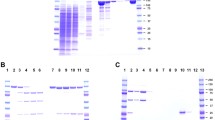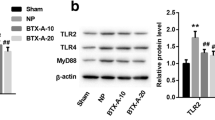Abstract
C3 exoenzyme from Clostridium botulinum, specifically ADP-ribosylates small GTP-binding proteins RhoA, B, and C. ADP-ribosylation causes functional inactivation of Rho proteins resulting in cessation of the complete downstream signaling. Rho proteins are general regulators of a lot of essential cellular functions, among others, the neuronal growth cone. Rho activation, triggered by neuronal injury, inhibits neuronal repair mechanisms. To prevent the detrimental effect of active Rho in the recovery of injured neuronal systems, C3 has become a promising drug to inactivate RhoA in neurons. During the advancement of C3 to a drug candidate, it was found that ADP-ribosyltransferase activity of C3, in fact, is not essential for axonal and dendritic growth and branching. Rather, a peptide fragment of C3 covering the surface exposed ARTT loop from C3 (C3154–182 peptide) is sufficient to induce growth and branching of neurons comparable to the effect of full-length C3. Whereas full-length C3 also acts on astrocytes and microglia to induce-at least in an in vitro model-inflammation and glial scar formation, C3154–182 peptide is inert and seems only to act on neurons. In addition to its axono- and dendritotrophic effects on cultured primary hippocampal neurons, C3154–182 peptide enhanced functional recovery and regeneration in a mouse model of spinal cord injury. Thus, in a proof-of-principle experiment, C3 peptide was shown to be efficacious in post-traumatic neuro-regeneration.

Similar content being viewed by others
References
Ahnert-Hilger G, Höltje M, Große G, Pickert G, Mucke C, Nixdorf-Bergweiler B, Boquet P, Hofmann F, Just I (2004) Differential effects of Rho GTPases on axonal and dendritic development in hippocampal neurons. J Neurochem 90:9–18
Aktories K, Just I (2005) Clostridial Rho-inhibiting protein toxins. Curr Top Microbiol Immunol 291:113–145
Aktories K, Bärmann M, Ohishi I, Tsuyama S, Jakobs KH, Habermann E (1986) Botulinum C2 toxin ADP-ribosylates actin. Nature 322:390–392
Aktories K, Weller U, Chhatwal GS (1987) Clostridium botulinum type C produces a novel ADP-ribosyltransferase distinct from botulinum C2 toxin. FEBS Lett 212:109–113
Aktories K, Wilde C, Vogelsgesang M (2004) Rho-modifying C3-like ADP-ribosyltransferases. Rev Physiol Biochem Pharmacol 152:1–22
Aspenström P, Fransson A, Saras J (2004) Rho GTPases have diverse effects on the organization of the actin filament system. Biochem J 377:327–337
Bertrand J, Winton MJ, Rodriguez-Hernandez N, Campenot RB, McKerracher L (2005) Application of Rho antagonist to neuronal cell bodies promotes neurite growth in compartmented cultures and regeneration of retinal ganglion cell axons in the optic nerve of adult rats. J Neurosci 25:1113–1121
Bertrand J, Di Polo A, McKerracher L (2007) Enhanced survival and regeneration of axotomized retinal neurons by repeated delivery of cell-permeable C3-like Rho antagonists. Neurobiol Dis 25:65–72
Bigalke H, Shoer LF (2000) Clostridial Neurotoxins. In: Aktories and Just (eds) Handbook of Experimental Pharmacology, vol 145 Bacterial Toxins pp 407–443
Boato F, Hendrix S, Hülsenbeck SC, Hofmann F, Große G, Djalali S, Klimaschewski L, Auer M, Just I, Ahnert-Hilger G, Höltje M (2010) C3 peptide enhances recovery from spinal cord injury by improved regenerative growth of descending fiber tracts. J Cell Sci 123:1652–1662
Chardin P, Boquet P, Madaule P, Popoff MR, Rubin EJ, Gill DM (1989) The mammalian G protein rhoC is ADP-ribosylated by Clostridium botulinum exoenzyme C3 and affects actin microfilament in Vero cells. EMBO J 8:1087–1092
Dergham P, Ellezam B, Essagian C, Avedissian H, Lubell WD, McKerracher L (2002) Rho signaling pathway targeted to promote spinal cord repair. J Neurosci 22:6570–6577
Dickson BJ (2001) Rho GTPases in growth cone guidance. Curr Opin Neurobiol 11:103–110
Dubreuil CI, Winton MJ, McKerracher L (2003) Rho activation patterns after spinal cord injury and the role of activated Rho in apoptosis in the central nervous system. J Cell Biol 162:233–243
Dubrueil CI, Marklund N, Deschamps K, McIntosh TK, McKerracher L (2006) Activation of Rho after traumatic brain injury and seizure in rats. Exp Neurol 198:361–369
Etienne-Manneville S, Hall A (2002) Rho GTPases in cell biology. Nature 420:629–635
Fahrer J, Kuban J, Heine K, Rupps G, Kaiser E, Felder E, Benz R, Barth H (2010) Selective and specific internalization of clostridial C3 ADP-ribosyltransferases into macrophages and monocytes. Cell Microbiol 12:233–247
Fujihara H, Walker LA, Gong MC, Lemichez E, Boquet P, Somlyo AV et al (1997) Inhibition of RhoA translocation and calcium sensitization by in vivo ADP-ribosylation with the chimeric toxin DC3B. Mol Biol Cell 8:2437–2447
Genth H, Gerhard R, Maeda A, Amano M, Kaibuchi K, Aktories K et al (2003a) Entrapment of Rho ADP-ribosylated by Clostridium botulinum C3 exoenzyme in the Rho-guanine nucleotide dissociation inhibitor-1 complex. J Biol Chem 278:28523–28527
Genth H, Schmidt M, Gerhard R, Aktories K, Just I (2003b) Activation of phospholipase D1 by ADP-ribosylated RhoA. Biochem Biophys Res Commun 302:127–132
Govek EE, Newey SE, Van AL (2005) The role of the Rho GTPases in neuronal development. Genes Dev 19:1–49
Hall A, Lalli G (2010) Rho and Ras GTPases in axon growth, guidance, and branching. Cold Spring Harb Perspect Biol 2:a001818
Han S, Arvai AS, Clancy SB, Tainer JA (2001) Crystal structure and novel recognition motif of rho ADP-ribosylating C3 exoenzyme from Clostridium botulinum: structural insights for recognition specificity and catalysis. J Mol Biol 305:95–107
Heasman SJ, Ridley AJ (2008) Mammalian Rho GTPases: new insights into their functions from in vivo studies. Nat Rev Mol Cell Biol 9:690–701
Hoffmann A, Hofmann F, Just I, Lehnardt S, Hanisch UK, Brück W, Kettenmann H, Ahnert-Hilger G, Höltje M (2008) Inhibition of Rho-dependent pathways by Clostridium botulinum C3 protein induces a proinflammatory profile in microglia. Glia 56:1162–1175
Höltje M, Hoffmann A, Hofmann F, Mucke C, Grosse G, Van Rooijen N, Kettenmann H, Just I, Ahnert-Hilger G (2005) Role of Rho GTPase in astrocyte morphology and migratory response during in vitro wound healing. J Neurochem 95:1237–1248
Höltje M, Hofmann F, Lux R, Veh RW, Just I, Ahnert-Hilger G (2008) Glutamate uptake and release by astrocytes are enhanced by Clostridium botulinum C3 protein. J Biol Chem 283:9289–9299
Höltje M, Djalali S, Hofmann F, Münster-Wandowski A, Hendrix S, Boato F, Dreger S, Große G, Henneberger C, Grantyn R, Just I, Ahnert-Hilger G (2009) A 29 amino acid fragment of Clostridium botulinum C3 protein enhances neuronal outgrowth, connectivity, and reinnervation. FASEB J 23:1115–1126
Huelsenbeck J, Dreger S, Gerhard R, Fritz G, Just I, Genth H (2007) Up-regulation of the immediate early gene product RhoB by exoenzyme C3 from Clostridium limosum and toxin B from Clostridium difficile. Biochemistry 46:4923–4931
Inoue S, Sugai M, Murooka Y, Paik S-Y, Hong Y-M, Ohgai H, Suginaka H (1991) Molecular cloning and sequencing of the epidermal cell differentiation inhibitor gene from Staphylococcus aureus. Biochem Biophys Res Commun 174:459–464
Jalink K, Van Corven EJ, Hengeveld T, Morii N, Narumiya S, Moolenaar WH (1994) Inhibition of lysophosphatidate- and thrombin-induced neurite retraction and neuronal cell rounding by ADP ribosylation of the small GTP-binding protein Rho. J Cell Biol 126:801–810
Just I, Boquet P (2000) Large clostridial cytotoxins as tools in cell biology. Curr Top Microbiol Immunol 250:97–107
Just I, Mohr C, Schallehn G, Menard L, Didsbury JR, Vandekerckhove J et al (1992a) Purification and characterization of an ADP-ribosyltransferase produced by Clostridium limosum. J Biol Chem 267:10274–10280
Just I, Schallehn G, Aktories K (1992b) ADP-ribosylation of small GTP-binding proteins by Bacillus cereus. Biochem Biophys Res Commun 183:931–936
Just I, Huelsenbeck SC, Genth H (2010) Clostridium Botulinum C3 Exoenzyme: Rho-inactivating tool in cell biology and a neurotrophic agent. The Open Toxinology Journal 3:19–23
Linseman DA, Loucks FA (2008) Diverse roles of Rho family GTPases in neuronal development, survival, and death. Front Biosci 13:657–676
Lord-Fontaine S, Yang F, Diep Q, Dergham P, Munzer S, Tremblay P, McKerracher L (2008) Local inhibition of Rho signaling by cell-permeable recombinant protein BA-210 prevents secondary damage and promotes functional recovery following acute spinal cord injury. J Neurotrauma 25:1309–1322
Mackay DJG, Nobes CD, Hall A (1995) The Rho's progress: a potential role during neuritogenesis for the Rho family of GTPases. Trends Neurosci 18:496–501
McKerracher L, Higuchi H (2006) Targeting Rho to stimulate repair after spinal cord injury. J Neurotrauma 23:309–317
Ménétrey J, Flatau G, Stura EA, Charbonnier J-B, Gas F, Teulon J-M et al (2002) NAD binding induces conformational changes in Rho ADP-ribosylating clostridium botulinum C3 exoenzyme. J Biol Chem 277:30950–30957
Ménétrey J, Flatau G, Boquet P, Ménez A, Stura EA (2008) Structural basis for the NAD-hydrolysis mechanism and the ARTT-loop plasticity of C3 exoenzymes. Protein Sci 17:878–886
Mimura F, Yamagishi S, Arimura N, Fujitani M, Kubo T, Kaibuchi K, Yamashita K (2006) Myelin-associated glycoprotein inhibits microtubule assembly by a Rho-kinase-dependent mechanism. J Biol Chem 281:15970–15979
Nadif KN, Van AL (2008) Rho-linked genes and neurological disorders. Pflugers Arch 455:787–797
Ridley AJ, Hall A (1992) The small GTP-binding protein rho regulates the assembly of focal adhesions and actin stress fibers in response to growth factors. Cell 70:389–399
Ridley AJ, Hall A (1994) Signal transduction pathways regulating Rho-mediated stress fibre formation: requirement for a tyrosine kinase. EMBO J 13:2600–2610
Rubin EJ, Gill DM, Boquet P, Popoff MR (1988) Functional modification of a 21-Kilodalton G protein when ADP-ribosylated by exoenzyme C3 of Clostridium botulinum. Mol Cell Biol 8:418–426
Schmandke A, Schmandke A, Strittmatter SM (2007) ROCK and Rho: biochemistry and neuronal functions of Rho-associated protein kinases. Neuroscientist 13:454–469
Sehr P, Joseph G, Genth H, Just I, Pick E, Aktories K (1998) Glucosylation and ADP-ribosylation of rho proteins: effects on nucleotide binding, GTPase activity, and effector coupling. Biochemistry 37:5296–5304
Sekine A, Fujiwara M, Narumiya S (1989) Asparagine residue in the rho gene product is the modification site for botulinum ADP-ribosyltransferase. J Biol Chem 264:8602–8605
Vogelsgesang M, Pautsch A, Aktories K (2007) C3 exoenzymes, novel insights into structure and action of Rho-ADP-ribosylating toxins. Naunyn Schmiedebergs Arch Pharmacol 374:347–360
Watabe-Uchida M, Govek EE, Van Aelst L (2006) Regulators of Rho GTPases in neuronal development. J Neurosci 26:10633–10635
Wennerberg K, Der CJ (2004) Rho-family GTPases: it's not only Rac and Rho (and I like it). J Cell Sci 117:1301–1312
Wiegers W, Just I, Müller H, Hellwig A, Traub P, Aktories K (1991) Alteration of the cytoskeleton of mammalian cells cultured in vitro by Clostridium botulinum C2 toxin and C3 ADP-ribosyltransferase. Eur J Cell Biol 54:237–245
Wilde C, Chhatwal GS, Schmalzing G, Aktories K, Just I (2001) A novel C3-like ADP-ribosyltransferase from Staphylococcus aureus modifying RhoE and Rnd3. J Biol Chem 276:9537–9542
Wilde C, Vogelsang M, Aktories K (2003) Rho-specific Bacillus cereus ADP-ribosyltransferase C3cer cloning and characterization. Biochemistry 42:9694–9702
Yamashita T, Higuchi H, Tohyama M (2002) The p75 receptor transduces the signal from myelin-associated glycoprotein to Rho. J Cell Biol 157:565–570
Author information
Authors and Affiliations
Corresponding author
Rights and permissions
About this article
Cite this article
Just, I., Rohrbeck, A., Huelsenbeck, S.C. et al. Therapeutic effects of Clostridium botulinum C3 exoenzyme. Naunyn-Schmied Arch Pharmacol 383, 247–252 (2011). https://doi.org/10.1007/s00210-010-0589-3
Received:
Accepted:
Published:
Issue Date:
DOI: https://doi.org/10.1007/s00210-010-0589-3




